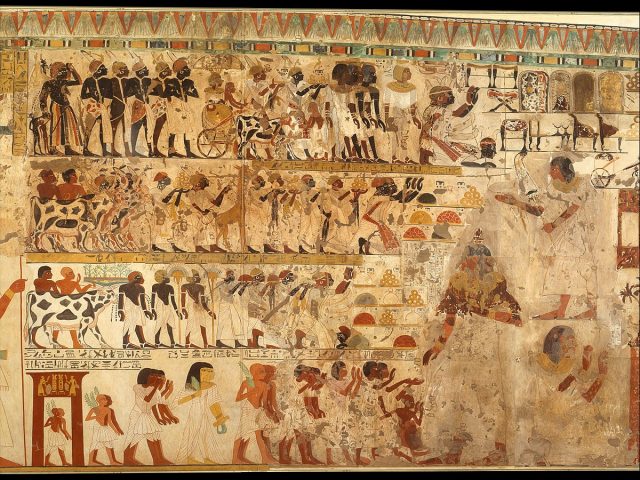https://www.thevintagenews.com/2020/03/17/black-pharaohs/
Divers Enter Underwater Tomb in Pyramids of Mysterious "Black Pharaohs"

An amazing underwater expedition is revealing more about the "Black Pharaohs" of Sudan and Egypt. Think about pyramids, and Egypt comes to mind. The great pyramids of Giza in Egypt are well known, but the country of Sudan actually has more pyramids. It boasts many more known royal burials in the pyramids at Nuri, a sprawling ancient necropolis. It covers over one hundred and seventy acres where the Nile River snakes around not far from the Egyptian border to the north and the Red Sea to the east.
Unfortunately, with the tombs so close to the Nile, the rising water table has caused some of them to flood, and those have become almost impossible to visit. Thanks in part to the National Geographic Society's financial assistance, Dr. Pearce Paul Creasman, an archeologist specializing in Egyptology and Sudanese history at the University of Arizona has been able to enter the Kush King Nastasen's underwater tomb – one of the "Black Pharaohs".

Pyramids of Sudan. Photo by Christopher Michel CC by 2.0
When Creasman and his dive partner, Kristin Romey of National Geographic swam into the first chamber it was fully under water. The collapsed roof of the second chamber allowed some airspace before they went through a small doorway to the third chamber which holds the submerged stone sarcophagus.
The two divers found pieces of gold leaf, probably from an artifact that did not survive the water and a shabti, a small figurine that would become a servant to the king in the afterlife. Now that they know what to expect and have worked out the bugs in their oxygen supply system, they will attempt to retrieve the sarcophagus next season.

Figurine found by the divers. Photo by NURI ARCHAEOLOGICAL EXPEDITON / PEARCE PAUL CREASMAN
Creasman told the BBC that the team "dug as far as we could" down a stairway of 65-steps which led to the entrance of the tomb. But then he adds "we got about 40 stairs down until we hit the water table and knew we wouldn't be able to go any further without putting our heads under". He described what he found as "remarkable".

Normal scuba tanks "would have been too cumbersome", Creasman said, so instead they used a hose that pumped oxygen from the surface on the dive. Photo by NURI ARCHAEOLOGICAL EXPEDITON / PEARCE PAUL CREASMAN
"There are three chambers, with these beautiful arched ceilings, about the size of a small bus, you go in one chamber into the next, it's pitch black, you know you're in a tomb if your flash lights aren't on. And it starts revealing the secrets that are held within."
Nastasen, the pharaoh whose tomb they were after, was a minor king of the Kush people who lived in the Nubian Desert, now Sudan. According to Ancient History Encyclopedia, the Nubian town of Kerma, established about 2400 BC, was a popular trading center in an area filled with abundant natural resources including ebony, incense, ivory, and especially gold which the powerful Egyptian government wanted. In about 1500 BC, the Pharaoh Thutmose I sent his armies south and destroyed Kerma, ending the freedom of the Kush. Thutmose III founded the town of Napata, incorporating the Kush into Egypt and extending Egyptian power.

Nubian Tribute Presented to the Egyptian King, Tomb of Huy circa 1353 –1327 B.C.
Over the next five hundred years, Egypt's government gradually became weaker until the Kush were able to conquer Egypt in the reign of King Piye about 743 to 712 BC. The Nubians then became the twenty-fifth dynasty of pharaohs in Egypt, now known as "The Black Pharaohs", and began building pyramids and using Egyptian hieroglyphs. This was a stable time for Egypt according to Livius. The Assyrians eventually drove the Nubians out of Egypt, and, in about 300 BC, the Nubians moved their capital further south to Meroë which soon became a wealthy and powerful city.
In 1913, Harvard Egyptologist, Dr. George Reisner began excavating Kerma and identifying all of the royal pyramids. He was able to write a history of the Kush including seventy generations of monarchs and the dates in which they ruled by deciphering the writings on the tombs. However for a long time Egyptologists and archeologists paid no attention to Nubian history and couldn't imagine that the "Black Pharaohs" could have built pyramids. Even the artifacts brought back by Reisner were largely put away and forgotten.
The tombs and their fascinating history were further pushed from the news by the discovery of Tutankhamun's tomb and by the fact that the water is rising, and any archeological project has to deal with traditional digs being impossible. According to National Geographic, Creasman just happens to be an Egyptologist as well as an underwater archeologist.
After his 2018 visit to the area, he began planning how to explore what had been unreachable without today's technology. Although the task to excavate the royal burial chambers is daunting, Creasman believes it can be done; that's the plan for 2020. He says, "It's a remarkable point in history that so few know about. It's a story that deserves to be told."
-- Sent from my Linux system.
No comments:
Post a Comment